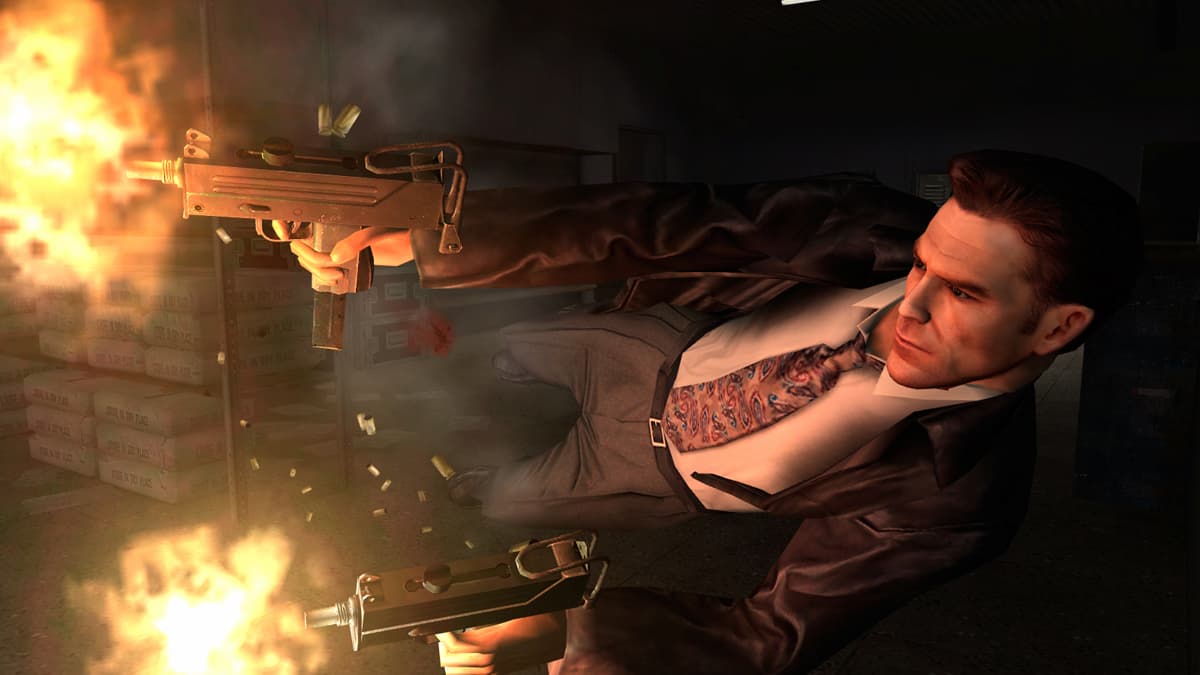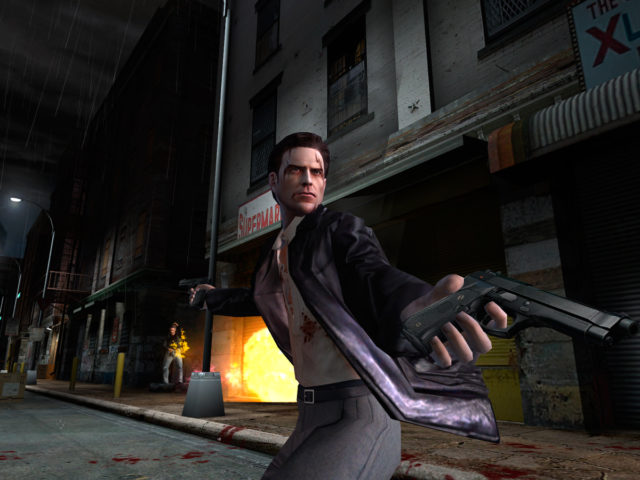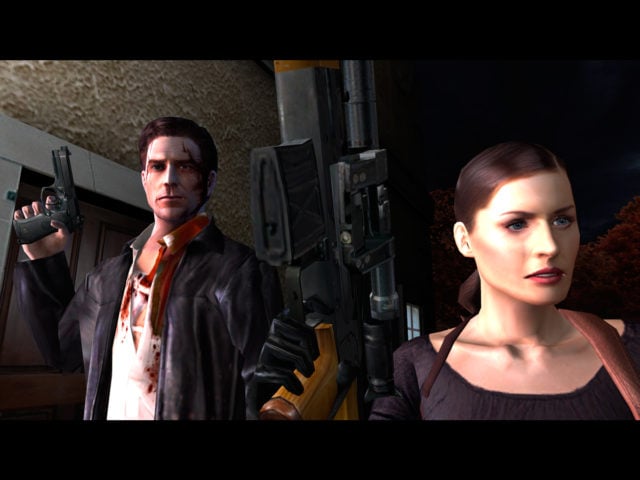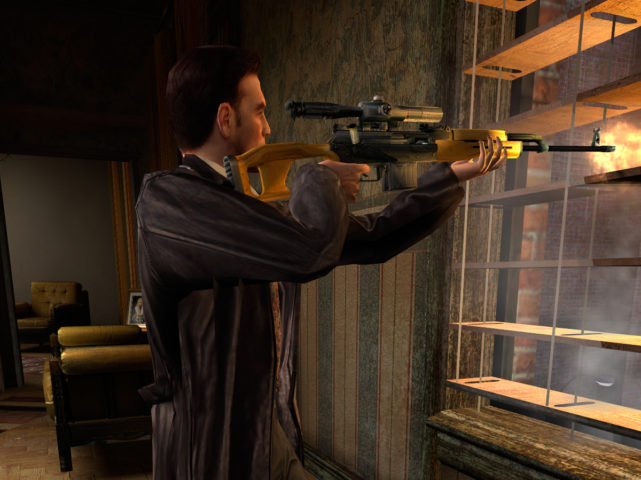Like the upcoming remakes, Max Payne 2 chooses what it must preserve and leave behind
“But I refused to give in, I had to continue.”

Image via Rockstar Games
Ahead of the tenth anniversary of Max Payne 3 in May, we’ll be publishing one essay from our Features Editor Grace Benfell once a month on each game in the series.
Writing these retrospectives ended up being surprisingly prophetic, as both Max Payne 1 and 2 are getting remakes from Remedy and Rockstar at… some point. After playing both these games, I’m hesitant about the possibility. Part of what makes Max Payne tick is its position in time. My last retrospective discussed the cavalcade of influences, from John Woo to Sin City. Max Payne’s place as response, homage, and elaboration through stylized, photographed cutscenes and blocky 3D figures is as important to its identity as bullet-time or James McCaffrey’s voice work. Any update will force these elements into a new context or get rid of them entirely.
Curiously though, a sequel has to do similar work. It must choose what from its inheritance to preserve or shift. For the most part, Max Payne 2 is a direct continuation of its predecessor, both in terms of narrative and play. That continuation comes with a multitude of joys. I love that Max downs only painkillers, never pausing to patch a wound or remove a bullet, implying that he carries every gunshot wound with him. It is bullet soaking as thematic edge, rather than simple contrivance.
I love that bodies flail and fall like awkward dance students or stunts gone wrong. I love how awkward but also how cool bullet-time is. Because the action can’t be choreographed, Max falls down more than gracefully dives. If you misjudge a leap, Max will gradually slide into a wall, a bad stunt take in slow motion. It’s funny and elegant, the kind of effect that could only be achieved with video game bodies. These are simple, gut-level pleasures, but both Max Payne games provide them with panache.

The differences are distinctly felt, even if they are scarce. For example, Max Payne 2 actually fares a little worse than its predecessor visually, simply because it leans harder on the in-game graphics, opting for traditional cutscenes more often. With a bigger budget and professional actors rather than studio mainstays, you can feel Remedy stretching toward the stylized quasi-realism of Quantum Break or Control. Fortunately, the game maintains a lurid vitality. The grimy comic book scenes are as fun and stunning as ever, though the more professional presentation loses some of the weird charm of the original. Both the “concrete” levels and the hallucinogenic dream sequences have a perfect strange hazy reality. Though I played it on PC, this game would look remarkable on a CRT.
Max Payne 2 reframes all the heady conspiracy of the first game with soap opera drama. The primary plot concerns the Illuminati crew of the Inner Circle falling apart, but the involved parties are people who Max knows, leading to a chain of lies and betrayals. Woden, the member of the Inner Circle who bailed Max out last time, is at the center of the conflict. Mona Sax, a mysterious femme fatale who was presumed dead at the end of the first game, becomes Max’s primary partner in crime. In the first game, Max was a lone gun, given only ghosts of help. Here, he has been tied to other individuals, to responsibilities, and to love.

That shift is thematic and practical. Mona Sax is not only a continuing complication in Max’s life, but a fellow protagonist and romantic interest. Several of the game’s most spectacular moments come from playing as Mona, navigating outside and around Max. Fittingly, the levels hit their stride when leaning into multiple perspectives. On several occasions, Max moves through a space once and then does it again from a higher vantage point. One setpiece tasks Mona with protecting Max, sniping foes high up in a construction site while Max flounders on the ground below. In the game’s most iconic set of levels, Max and Mona navigate a funhouse, at first straightforwardly, then by moving through the backstages, then through the building as it burns away. This constant revisitation is one of the game’s core pleasures. While the first game felt like moving through a set of desperate dioramas, the second has at least the pastiche of real place. Max Payne’s world is at once more expansive and more splintered.
The game itself mimics this fractured structure with the TVs scattered throughout each level. As Max approaches the TV they play episodes of various TV shows: a blaxploitation procedural called Dick Justice, a costume drama known as Lords and Ladies, as well as the Twin Peaks– inspired Address Unknown. All of these disparate shows reflect back on Max in some way. Notably, Sam Lake no longer plays Max Payne in the comic book segments, but he shows up in the low-resolution frames of the television frequently. It’s a showcase of developer Remedy’s ongoing obsession with doubles and alternate selves. The magic here is that it is mostly internal and introspective, not literal. Max never encounters any literal doubles; instead, he feels torn, and the structure of the game itself twists and turns to accommodate that feeling.

That shifting sense of self comes with hard limits when it comes to gender. Early in the game, after some of the big bad’s henchmen murder a gun shop owner with ties to the Russian mob, Max remarks, “Like all things wrong in my life, it started with the death of a woman.” Max Payne’s usage of female characters merely as props or dead wives is obviously misogynistic, but the second game’s expanded cast leads to more complex characters and more damning problems.
Though Mona Sax is obviously an alternate version of Max in some sense, it’s his name that matters. Though multiple levels take place from her perspective, Max is always the one who narrates. She is clearly confident and powerful, but her story is nevertheless secondary. Ultimately, her death at the game’s end is a sign of Max’s own tortured cycles of violence and pain more than anything else. Still, she can live. Playing the game on the highest difficulty settings unlocks a secret ending where she miraculously survives. While the dialogue frames it as an undeserved miracle, the game makes it into a contest of Max’s own will — one that is still futile, as Mona is canonically dead in Max Payne 3. Though Mona and Max start to share a shifting self, it dies by the game’s end.
Max Payne 2 is at once additive and reductive. In its emphasis on a more personal structure, it loses the strong meta elements of the original. It also gains an equally haunting and hilarious psychology, filtered through the refined, silly tropes of television and pop culture. It loses the charming DIY aesthetic for an even more striking, gritty look. Its expansion of the supporting cast emphasizes the franchise’s misogyny, but also frees up its narrative and gives space and power to its female characters. Like any future version of Max Payne, you can feel what it chooses to preserve and what it left behind.